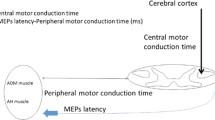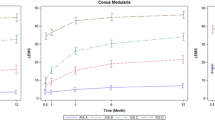Objectives. To study the neurophysiological mechanisms of formation of motor deficit in patients with posttraumatic cervical myelopathy. Materials and methods. A retrospective clinical-neurophysiological study was performed from 2008 to 2018 involving 190 patients undergoing rehabilitation therapy at the Preodolenie Rehabilitation Center; the study included 39 women and 151 men, mean age 27 [21.0; 36.0] years, at 3 [1.0; 8.0] years after spinal cord trauma. On admission for rehabilitation therapy, all patients underwent investigations of neurological status with assessments on the International Standards for Neurological Classification of Spinal Cord Injury (ISNSCI) and nerve conduction studies. A total of 160 left and 145 right median nerves were investigated, along with 161 left and 151 right tibial nerves and 90 left and 66 right ulnar nerves. Total muscle potential (TMP) amplitudes were assessed, along with M responses and excitation conduction velocities (ECV) for the distal parts of motor fibers, repeat investigations were carried out (n = 95) at 6 [3.0; 10.0] years after trauma, the time between investigations being 2.9 [1.0; 4.0] years. The reference group for TMP and ECV of the median nerve consisted of 10 patients with traumatic paraplegia and the reference group for the tibial nerve consisted of 12 patients; there were no significant differences in age and sex composition. Results. In the study group, TMP amplitude in the median nerve was 4.1 [1.6; 6.1] mV and ECV was 56 [51.0; 61.0] m/sec, compared with TMP 11 [7.50; 16.40] mV (p = 0.00) and ECV 59 [58.0; 62.0] m/sec (p = 0.00) in the reference group; analysis of data for the tibial nerve in the study group gave TMP 4.3 [0.65; 7.95] mV and ECV 43 [39.0; 48.0] m/sec, with the reference group giving TMP 8.4 [6.4; 10.1] mV (p = 0.00) and ECV 50 [47.0; 51.0] m/sec (p = 0.00). Marked denervation changes were seen in 20% of patients. Signs of axonal neuropathy were more marked in all nerves in patients with complete spinal cord injury as compared with patients with partial injuries, while both tibial nerves showed decreased ECV. Studies of the median nerves in patients with lesions at C7–T1 showed significant reductions in TMP amplitude on the left (2.5 [0.55; 5.65] mV) and right (2.7 [0.80; 6.30] mV) as compared with patients with the clinical signs of lesions at C4–C6, in whom M responses on the left were 4.6 [2.30; 6.20] mV (p = 0.03) and on the right were 4.7 [2.80; 6.10] mV (p = 0.03). Conclusions. The main mechanism of peripheral nervous system damage in patients with posttraumatic cervical myelopathy was a combination of neuron damage at the level of the primary spinal cord lesions with secondary axonal neuropathy caudal to the injury level within three years of injury.
Similar content being viewed by others
References
S. C. Schrader, T. B. Sloan, and J. R. Toleikis, “Detection of sacral sparing in acute spinal cord injury,” Spine, 12, 533–535 (1987), https://doi.org/https://doi.org/10.1097/00007632-198707000-00004.
A. Curt, M. E. Keck, and V. Dietz, “Functional outcome following spinal cord injury: Significance of motor evoked potentials,” Arch. Phys. Med. Rehabil., 79, 81–86 (1998), https://doi.org/https://doi.org/10.1016/s0003-9993(98)90213-1.
A. Curt and V. Dietz, “Ambulatory capacity in spinal cord injury: Significance of somatosensory evoked potentials and ASIA protocols in predicting outcome,” Arch. Phys. Med. Rehabil., 78, 39–43 (1997), https://doi.org/https://doi.org/10.1016/s0003-9993(97)90007-1.
A. Curt and V. Dietz, “Traumatic cervical spinal cord injury: Relation between somatosensory evoked potentials, neurological deficit and hand function,” Arch. Phys. Med. Rehabil., 77, 48–53 (1996), https://doi.org/https://doi.org/10.1016/s0003-9993(96)90219-1.
V. Dietz, M. Wirz, A. Curt, and G. Colombo, “Locomotor pattern in paraplegic patients: Training effects and recovery of spinal cord function,” Spinal Cord, 36, 380–390 (1998).
A. Curt, B. Rodic, B. Schurch, and V. Dietz, “Recovery of bladder function in patients with acute spinal cord injury: Significance of ASIA scores and SSEP,” Spinal Cord, 35, 368–373 (1997).
B. Nitsche, H. Perschak, A. Curt, and V. Dietz, “Loss of circardian blood pressure variability in complete tetraplegia,” J. Hum. Hypertens., 10, 311–317 (1996).
A. Curt and V. Dietz, “Neurographic assessment of intramedullar motoneurone lesions in cervical spinal cord injury: Consequences for hand function,” Spinal Cord, 34, 326–332 (1996).
E. Boltshauser, W. Isler, H. U. Bucher, and H. Friderich, “Permanent flaccid paraplegia in children with thoracic spinal cord injury,” Paraplegia, 19, 227–234 (1981), https://doi.org/https://doi.org/10.1038/sc.1981.46.
A. Curt, M. E. Keck, and V. Dietz, “Clinical value of F-wave recordings in traumatic cervical spinal cord injury,” Electroencephalogr. Clin. Neurophysiol., 105, 189–193 (1997), https://doi.org/https://doi.org/10.1016/s0924-980x(97)96626-1.
S. Kirshblum, S. Lim, S. Garstang, and S. Millis, “Electrodiagnostic changes of the lower limbs in subjects with chronic complete cervical spinal cord injury,” Arch. Phys. Med. Rehabil., 82, 604–607 (2001), https://doi.org/https://doi.org/10.1053/apmr.2001.22348.
C. S. Lin, V. G. Macefield, M. Elam, et al., “Axonal changes in spinal cord injured patients distal to the site of injury,” Brain, 130, 985–994 (2007), https://doi.org/https://doi.org/10.1093/brain/awl339.
H. Van De Meent, A. J. F. Hosman, J. Hendriks, et al., “Severe degeneration of peripheral motor axons after spinal cord injury: A European Multicenter study in 345 patients,” Neurorehabil. Neural Repair, 24, No. 7, 657–665 (2010), https://doi.org/https://doi.org/10.1177/1545968310368534.
S. Rutz, V. Dietz, and A. Curt, “Diagnostic and prognostic value of compound motor action potential of lower limbs in acute paraplegic patient,” Spinal Cord, 38, No. 4, 203–210 (2000)..
A. Curt and V. Dietz, “Nerve conduction study in cervical spinal cord injury: significance for hand function,” Neurorehabilitation, 7, 165–173 (1996), https://doi.org/https://doi.org/10.3233/NRE-1996-7302.
R. J. Marino, T. Barros, F. Biering-Sorensen, et al., “International standards for neurological classification of spinal cord injury,” J. Spinal Cord. Med., 26, Suppl. 1, 50–56 (2003), https://doi.org/https://doi.org/10.1080/10790268.2003.11754575.
W. J. Hennessey, F. J. E. Falco, and R. L. Braddom, “Median and ulnar nerve conduction studies: normative data for young adults,” Arch. Phys. Med. Rehabil., 75, 259–264 (1994), https://doi.org/https://doi.org/10.1016/0003-9993(94)90025-6.
R. M. Buschbacher, “Tibial nerve motor conduction to the abductor hallucis,” Am. J. Phys. Med. Rehabil., 78, No. 6, Suppl., 15–20 (1999), https://doi.org/https://doi.org/10.1097/00002060-199911001-00004.
J. H. Nogajski, S. Engel, and M. C. Kiernan, “Focal and generalized peripheral nerve dysfunction in spinal cord-injured patients,” J. Clin. Neurophysiol., 23, No. 3, 273–279 (2006), https://doi.org/https://doi.org/10.1097/01.wnp.0000201062.99671.27.
K. C. Hayes, T. C. Hull, G. A. Delaney, et al., “Elevated serum titers of proinflammatory cytokines and CNS autoantibodies in patients with chronic spinal cord injury,” J. Neurotrauma, 19, 753–761 (2002), https://doi.org/https://doi.org/10.1089/08977150260139129/.
S. A. Berman, R. R. Young, M. Sarkarati, and J. M. Shefner, “Injury zone denervation in traumatic quadriplegia in humans,” Muscle Nerve, 19, 701–706 (1996), https://doi.org/https://doi.org/10.1002/(SICI)1097-4598(199606)19:6<701::AID-MUS3>3.0.CO;2-E.
C. S. Lin, V. G. Macefield, M. Elam, et al., “Axonal changes in spinal cord injured patients distal to the site of injury,” Brain, 130, 985–994 (2007), https://doi.org/https://doi.org/10.1093/brain/awl339.
C. W. Chang, “Evident transsynaptic degeneration of motor neurons after stroke: a study of neuromuscular jitter by axonal microstimulation,” Electroencephalogr. Clin. Neurophysiol., 109, 199–202 (1998).
S. Mangold, T. Keller, A. Curt, and V. Dietz, “Transcutaneous functional electrical stimulation for grasping in subjects with cervical spinal cord injury,” Spinal Cord, 43, No. 1, 1–13 (2005), https://doi.org/https://doi.org/10.1038/sj.sc.3101644.
V. Chaudhry, D. R. Cornblath, E. D. Mellits, et al., “Inter- and intra- examiner reliability of nerve conduction measurements in normal subjects,” Ann. Neurol., 30, No. 6, 841–843 (1991), https://doi.org/https://doi.org/10.1002/ana.410300614.
H. W. Axelson, “Compound motor action potential interexaminer variability in photoguided placement of the recording electrodes,” J. Clin. Neurophysiol., 29, No. 3, 256–259 (2012), https://doi.org/https://doi.org/10.1097/WNP.0b013e3182570f6e.
Author information
Authors and Affiliations
Corresponding author
Additional information
Translated from Zhurnal Nevrologii i Psikhiatrii imeni S. S. Korsakova, Vol. 120, No. 4, Iss. 1, pp. 7–13, April, 2020.
Rights and permissions
About this article
Cite this article
Bushkov, F.A., Bzhilyansky, M.A. Mechanisms of Changes in the Segmental Neuromotor Apparatus in Patients with Posttraumatic Cervical Myelopathy. Neurosci Behav Physi 51, 16–22 (2021). https://doi.org/10.1007/s11055-020-01033-7
Received:
Accepted:
Published:
Issue Date:
DOI: https://doi.org/10.1007/s11055-020-01033-7




